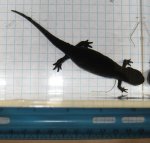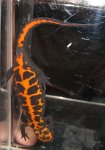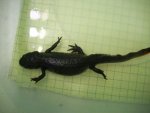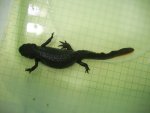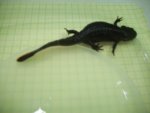I´m a bit stumped with that female of yours, Jen. Everything says orientalis, the shape of the head, the tail, the cloacal coloration, even the clearly visible lateral line and yet...there is something odd in the belly. The shape and arrangement of the black marks reminds me a lot of pyrrhogaster juveniles, but not of any orientalis i´ve ever seen up close.
Age and access to food certainly are very important factors in determining the size of caudates but there must be a genetic component too. I have a CB male, i think 3 years old by now (i´d have to check), he is fully mature in every way but he is tiny at perhaps a bit less than 5,5cm long. It´s certainly not a matter of food as he is a little pig and i´m rather generous with the orientalis because of the ever present larvae. He is adorable, though...there is a definite inverse correlation between size and cuteness.
 ) as I saw some claims that H.orientalis do not reach 10cm. Shouldnt really come as a surprise as they grow throughout their life and I suspect we rarely see animals over 10 years old. I have had this animal for 6-7 years and she came to me as an adult, most likely WC.
) as I saw some claims that H.orientalis do not reach 10cm. Shouldnt really come as a surprise as they grow throughout their life and I suspect we rarely see animals over 10 years old. I have had this animal for 6-7 years and she came to me as an adult, most likely WC.
